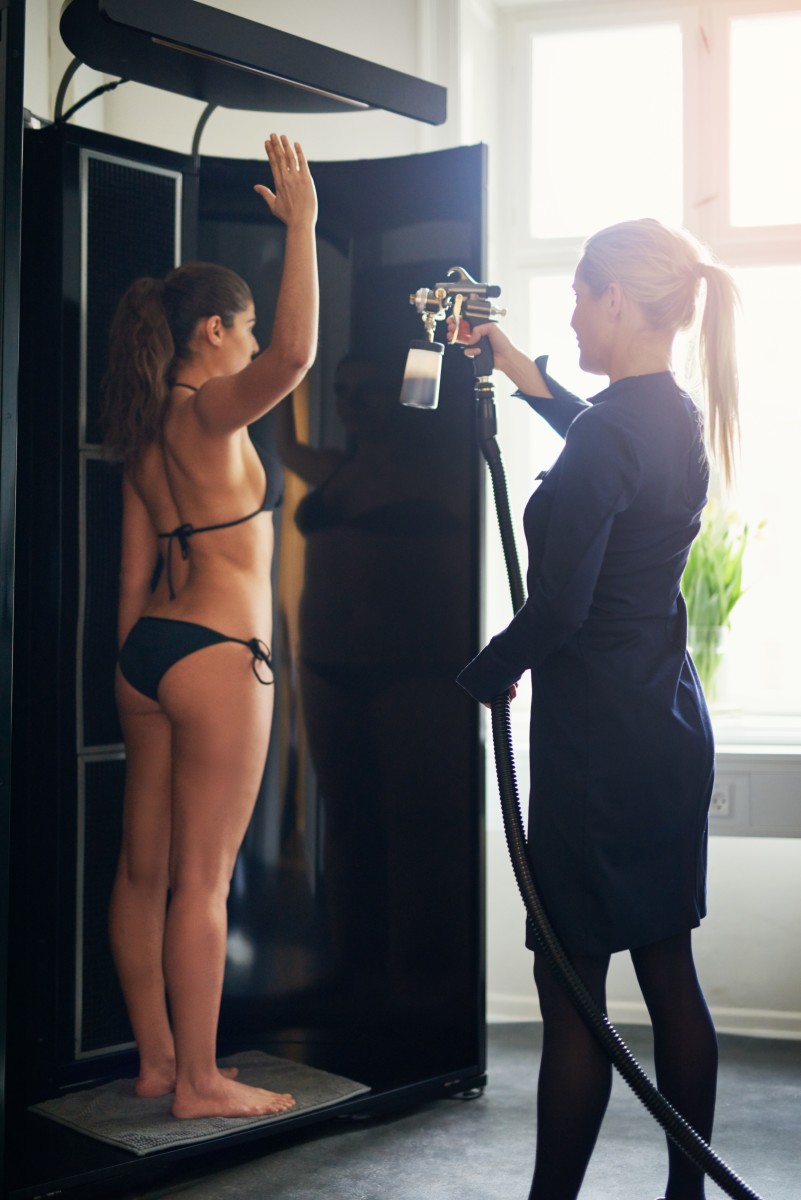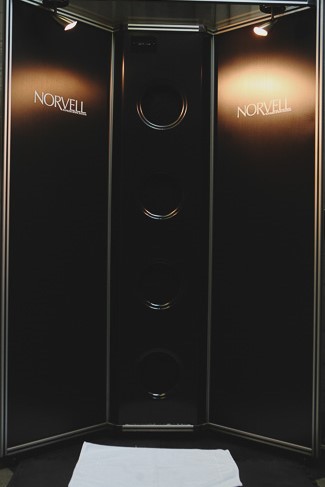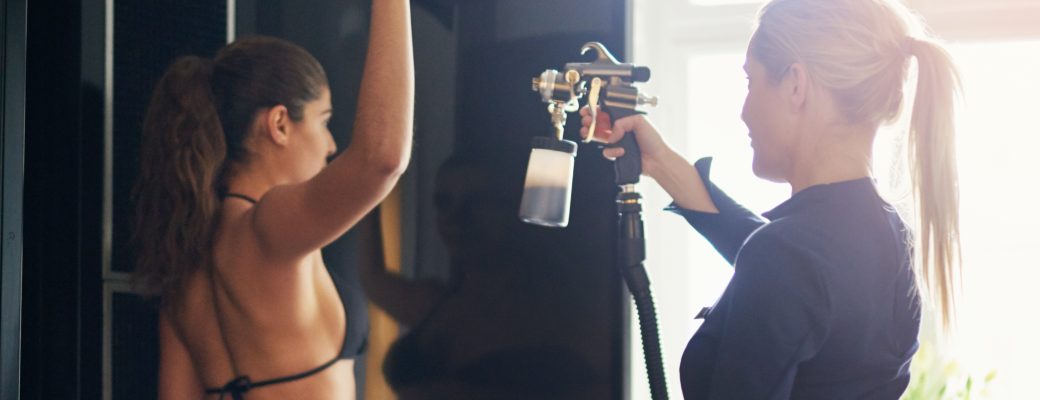The ins and outs of airbrush tanning
Are you ready to dive into the sunless tanning industry, but you’re unsure how to set up your room? After almost 10 years in the industry, I’ve been there, done that. From starting in my parents’ garage (yes, I was that girl), to mobile tanning, then a one-room rental, to now owning a full-service day spa, I’ve gained so much insight into the workings of the tanning industry. My spa now has three separate airbrush rooms in which we are able to accommodate a client in each room every 20 minutes, which comes to 90 tans a day when fully booked. That’s a lot of tans, right? That’s also a ton of solution, particulates, messiness, product and bronzer!
Over the years, I have researched and tested many setups. My biggest piece of advice is to figure out whether or not you are absolutely sure you want to dive into the airbrush business – it is not as easy as it may sound. This business can be extremely overwhelming, inefficient and a plain mess if not done correctly.
Following are some of the ins and outs of setting up an airbrush tanning room, including what has and has not worked for me.
A few things to consider:
- Everything will get bronzer on it – the walls, the floors, the compressor, the outside of the room (yes, the solution gets everywhere), chairs or anything else that may be inside the room. Bronzers are typically sticky, so be prepared for everything to become sticky as well. A win-win!
- A proper room is not a curtain in the background and a fan with a filter on top – that type of setup would be for minimal sprays. As your clientele increases, an investment in your equipment and setup is recommended.
How to set up your airbrush room:

- Purchase a professional compressor: A mini mobile compressor is not going to cut it when your clientele begins to grow. If you are able to find a compressor on eBay, great, but in my experience, the ones found there can be hit-or-miss because, typically, the seller is only a reseller and does not truly know the age of the compressor. Of the three I’ve purchased on eBay, one did not turn on at all, another one was great and lasted almost two years, and the third one lasted only a few months. On average, I go through one professional-grade compressor every year due to the amount of airbrush tans my spa services. Typically, though, airbrush compressors will last longer than that (again, my business has very high volume). There was one year I went through three compressors, as they (unfortunately) happened to go out around the same time. Be prepared to spend about $300-$500 for a used one and $500-$1,200 for a top-grade new one. Two personal favourite compressors are Norvell and California Tan. If you are able to afford a quiet box, I would recommend that as well.
- The room(s): Unless you have a fully enclosed airbrush boxed panel, your walls are going to get covered in bronzer. Tiles are preferred, as they are durable and easy to wash. If that’s not possible, consider Formica panels that are easily washable near the areas needed most. I have two large-sized panels in each room – one directly behind an airbrush panel and the second one on the side the airbrush gun will overspray. They were custom-ordered from a bath remodel specialist and I matched the colour of my room (a blue-grey tone) to blend in nicely.
If you are able to install plumbing and a drain, consider yourself lucky. It would be a luxury to rinse down the room when needed and have the bronzer drain out seamlessly. I have concrete floors and the expense would be too costly, so this is not an option at my current location.
- Containers: Plastic containers are a wonderful option for storing supplies needed during your service. Plastic is easy to clean, so whenever the bronzer builds up, you can take the products out and wash the containers.
Other supplies will include: disposable women’s bikinis and men’s briefs, hair caps, wipes to remove makeup and deodorant, bobby pins and gloves. We use non-latex gloves as we have found many clients have latex allergies. The glove boxes are hung on the wall for easy access and are in sizes extra small to medium.

- Overspray reduction booth: If I had to purchase them again, I would get panels that break down easily and can be carried out of the room to wash. The current ones we have are large and extremely difficult to move out of the room. It depends on what type you get, but airbrush panels can cost as much as $2,000. Purchase some floor mats from Amazon or your local sports store and place them under the reduction booth and around the area the client will stand. They are cushioned and can be easily washed. I prefer dark gray mats with a thicker cushion. Over the floor mats, we offer each client a fresh towel to stand on. White towels, in my opinion, look the cleanest and freshest, and the bronzer easily washes out of them, so we are able to use them over and over again. A cleaning service comes to our spa daily to wash the towels.
- Mini split units: A high-volume airbrush room will be hot, hot, hot, and it also needs to have the air filtered out. We can instantly tell when our mini split unit is not on as the room will quickly start to feel muggy and begin to look cloudy. The mini split unit pumps cool air into the room and also pulls out a decent amount of particulates (the overspray of the solution will break down into small particulates and get everywhere). Mini split units are costly but effective. Also note that they require a good deal of maintenance – we have to clean our filters weekly and spray the unit with a vinegar-water mix to break down the sugars over the coils. Our units are also maintained quarterly by our HVAC company.
- Ceiling tiles: Yes, this is something to think about. Before we changed to our current tiles, the ceiling was getting bronzer on it. We switched to a vinyl tile, which allows the solution to wash right off, and our cleaners wash both our walls and our ceiling regularly to keep them well maintained.
- Have a tight cleaning system in place with your team: Cleaning is a top priority. My spa has both a weekly and daily cleaning list, so that all airbrush guns and overspray booth filters are cleaned each night. Proper airbrush gun care is essential to keep it functioning properly, as the buildup of the solution can easily affect the “needle” of the gun and the way the solution is sprayed.
- Backup, backup, backup: You’d better believe our spa has a backup of everything: airbrush guns, hoses, mobile mini sprayer for compressor outages, airbrush gun parts, filters, etc. There is nothing worse than having a full day booked of airbrush tans and not having the parts you need to complete them. Keep a log of the parts the airbrush gun needs and be sure to keep the manual handy. I have a list of how to fix airbrush gun issues and what parts I will need easily accessible to myself and the team.
- Solution set up: Decide how many solution options you will offer. You will need to keep them separate – an option for this is to get plastic pouring containers (we use the Rubbermaid ones with the caps on them) and label each solution. Ours are all set on a plastic three-shelved stand. Our pH balance prep spray, barrier cream and airbrush overflow booth cleaning solution are also kept on the shelf.
Ready, set… airbrush! Now you are on your way to creating your own sunless airbrush studio. Get ready to be a bronzed professional in no time.




